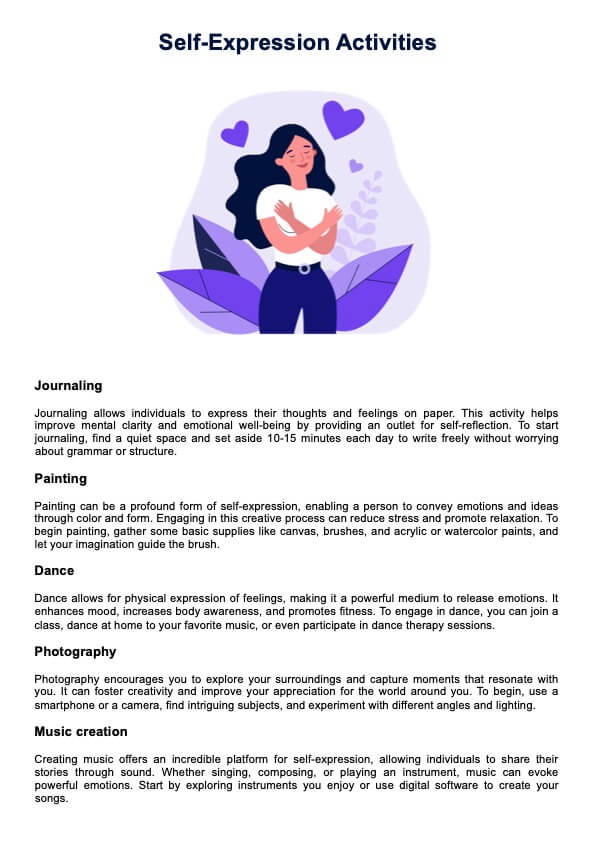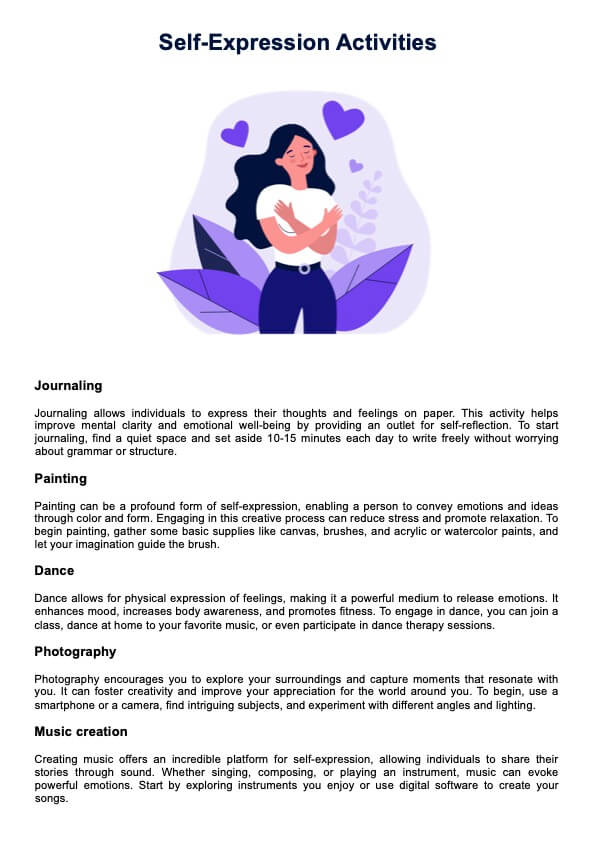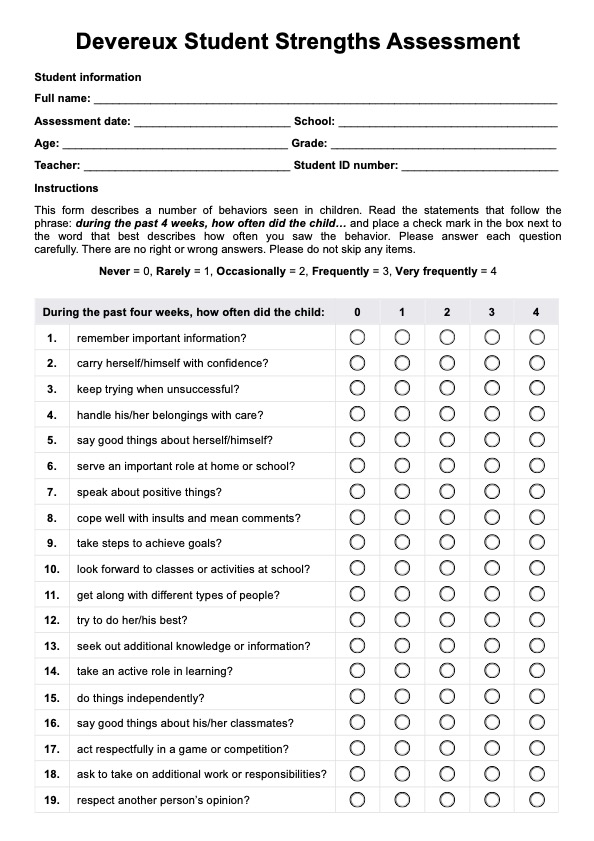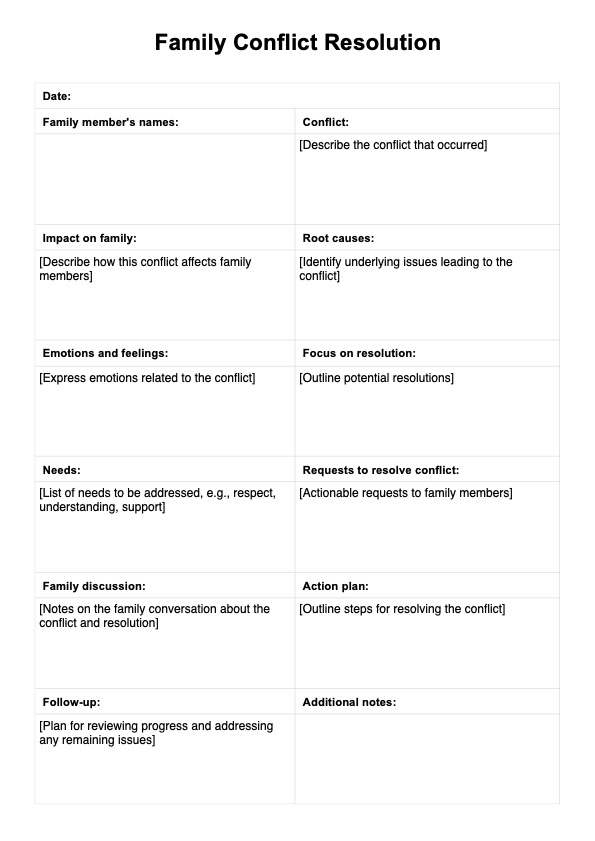Self-Expression Activities
Discover creative Self-Expression Activities that enhance mental health and identity. Explore techniques like art, writing, and dance to foster personal growth.


Importance of self-expression
Self-expression is a crucial aspect of clinical practice, significantly impacting clients' mental health and identity development. It is an essential therapeutic tool, enabling clients to convey their own words, thoughts, emotions, and individuality, which is fundamental for psychological well-being.
Facilitating authentic self-expression can significantly enhance emotional awareness and reduce symptoms of stress, anxiety, and depression. When clients feel free to express their thoughts and feelings, it fosters a sense of control and self-worth, which are integral to building psychological resilience. This process provides clients with a means to process and better understand complex emotions.
Self-expression is also vital for identity formation. It allows clients to explore and affirm their identities, which is essential for developing a strong sense of self. Healthcare professionals can use various forms of self-expression, such as art therapy, writing therapies, and expressive speech techniques, to help clients articulate their unique perspectives and experiences. This contributes to a more defined and robust personal identity.
Incorporating self-expression into therapy encourages empathy and understanding, reinforcing social connections and a sense of belonging. These interactions enhance clients' mental health by creating art promoting a supportive network that values individual differences.
Self-Expression Activities Template
Self-Expression Activities Example
Why is self-expression important to mental health and identity?
Self-expression is crucial in therapeutic settings as it directly impacts clients' mental health, emotional awareness, and identity development. It enables clients to communicate their thoughts, feelings, and experiences, which is essential for understanding themselves and being understood by others. For mental health, self-expression acts as a release mechanism, helping to alleviate stress and prevent the buildup of emotions that can lead to anxiety and depression.
In terms of identity, self-expression is vital for personal development and authenticity. It allows clients to explore and affirm their values, beliefs, and interests, contributing to a strong and coherent sense of inner self itself. Thus, self-expression is not merely about sharing oneself with others; it is also about self-discovery and self-confirmation, which are pivotal in fostering a healthy, resilient identity.
Healthcare professionals can facilitate self-expression by creating a safe and supportive environment where clients feel comfortable exploring and expressing their emotions and identities. Utilizing techniques such as art therapy, writing exercises, and role-playing can encourage clients to express themselves and build a more robust sense of self.
5 examples of Self-Expression Activities
Self-Expression Activities are vital for individuals to communicate their inner thoughts, feelings, and identities. Here are five effective self-expression art activities:
Expressive writing
Writing is a powerful medium for self-expression. Individuals can engage in various forms, such as journaling, poetry, or prose. A recommended exercise is to perform a "brain dump," where one writes continuously for 15 minutes about any thoughts or feelings without worrying about structure or grammar. This practice helps clarify emotions, ideas, and thoughts, allowing for deeper self-understanding and expression.
Creative arts
Engaging in artistic activities like drawing, painting, or crafting can be a significant outlet for self-expression and help individuals explore their creative spirit. These activities allow individuals, especially younger children, to convey their emotions and thoughts visually. For instance, creating a piece of art on paper that reflects personal experiences or feelings can be both therapeutic and revealing.
Dance
Dance is a universal form of self-expression that transcends language. It allows individuals to express emotions and feelings through their body language and movement. Whether through structured dance classes or free-form movement at home, dancing can help release pent-up emotions and foster a sense of freedom and joy.
Fashion and personal style
How individuals dress can be a profound form of self-expression. Choosing clothing that reflects personal values, beliefs, moods, or styles allows individuals to communicate their identity to the world. Customizing clothing or experimenting with different styles can enhance this form of expression, making it a creative outlet.
Performing arts
Participating in performing arts such as singing, acting, or playing music provides a dynamic way to express oneself. These activities not only allow for emotional release but also help individuals connect with others through shared life experiences. Performing in front of an audience can enhance confidence and foster a sense of community as individuals share their talents and stories.
How does our Self-Expression Activities handout work?
Our Self-Expression Activities handout is designed to provide healthcare professionals with a clear and comprehensive guide to fostering self-expression and creativity among clients. It is structured to present information efficiently, making it easy to incorporate these activities into therapeutic settings. Here's how to use the handout:
Step 1: Download the Self-Expression Activities handout
Get a copy of the handout using the link on this page. It's also available via the Carepatron app. You can either print a copy or use a digital format for your convenience.
Step 2: Explain the purpose of Self-Expression Activities
Before starting any activity, take a moment to explain why self-expression is important and how these activities can help your client healthily express themselves. This will give them a better understanding and motivation to participate.
Step 3: Encourage your client to express themselves freely
Tell your client to try some of the activities without any expectations or limitations. Encourage them to express themselves freely and openly, without worrying about judgment or criticism.
Step 4: Provide guidance and support
As your client engages in Self-Expression Activities be there to offer guidance and support. Ask open-ended questions to delve deeper into their thoughts and emotions, and provide reassurance when needed.
Step 5: Make adjustments as needed
Keep in mind that not all activities may work for every client. Be prepared to make adjustments as needed, whether it's modifying an activity or suggesting a different one altogether.
How this handout may benefit mental health professionals
This handout is a valuable resource for mental health professionals by providing them with structured information and practical insights into the importance of creative expression and self-expression for mental health and identity. It can enhance therapeutic practices in several ways:
- Educational tool: The handout can be used as an educational tool to enlighten therapists and counselors about the critical role self-expression plays in emotional well-being and identity formation. Understanding these aspects can help professionals more effectively address and support these areas in therapy sessions.
- Client engagement: Professionals can share this handout with clients as part of therapy sessions or workshops, facilitating discussions about the benefits of self-expression and strategies for improving it. This can help clients feel more empowered to explore and express their feelings, thoughts, and identities.
- Enhancing interventions: By incorporating the concepts and strategies outlined in the handout, mental health professionals can develop more targeted interventions that encourage self-expression. This can be particularly beneficial in treatments focusing on emotional disorders, where expression is often inhibited or distorted.
Commonly asked questions
Social norms, fear of judgment or rejection, and lack of confidence can prevent a person from practicing self-expression. Additionally, past traumas or restrictive environments may inhibit an individual or child's willingness or ability to express themselves freely.
Not being able to express oneself with words can lead to increased stress, anxiety, and depression, as emotions and thoughts are suppressed. This suppression can diminish self-esteem and hinder personal growth, potentially resulting in a weakened sense of identity and isolation from others.
Mental health professionals help clients with self-expression by creating a safe and supportive environment where clients can explore and articulate their feelings without fear of judgment. They may use techniques such as therapy, art, or writing exercises to encourage clients to express their thoughts and emotions more freely.




















-template.jpg)



















































































